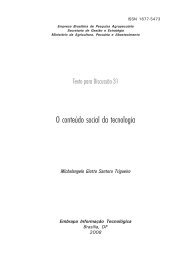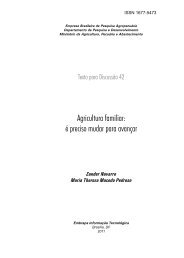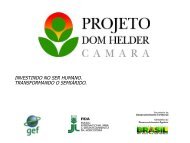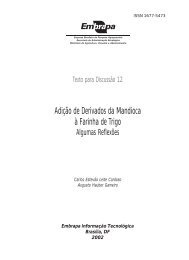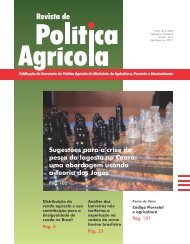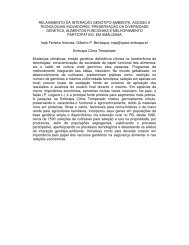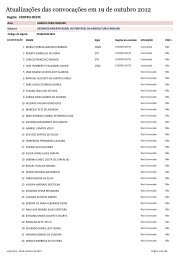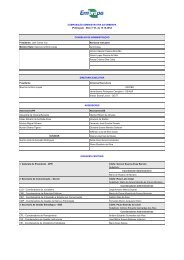Ministry of Agriculture, Livestock and Food Supply - Embrapa
Ministry of Agriculture, Livestock and Food Supply - Embrapa
Ministry of Agriculture, Livestock and Food Supply - Embrapa
You also want an ePaper? Increase the reach of your titles
YUMPU automatically turns print PDFs into web optimized ePapers that Google loves.
At the same time, while the productivity <strong>of</strong> the sugar & alcohol sector<br />
was increasing, petroleum quotes rose again, fluctuating around US$ 25.00/<br />
barrel from 2000 to 2002. With higher prices <strong>and</strong> an higher tax load on fossil<br />
fuels, alcohol was once again attractive <strong>and</strong>, consequently, the automobile<br />
industry began investing in a new technological st<strong>and</strong>ard: the bi-fuel or dual<br />
fuel, alcohol-gasoline car, also called by the North American expression, flex fuel.<br />
The refueling flexibility <strong>of</strong> these vehicles, which have practically eliminated<br />
the risk <strong>of</strong> running out <strong>of</strong> fuel, combined with attractive alcohol prices has<br />
redirected the market: first released in March 2003, approximately 850,000<br />
dual fuel vehicles were circulating in Brazil by late 2005. Six automobile<br />
manufacturers installed in the country <strong>of</strong>fer 52 different models9 . These<br />
numbers predict the dawn <strong>of</strong> a new era in which multi-fuel vehicles will<br />
dominate the market almost absolutely, <strong>and</strong> this should favor enormously the<br />
consumption <strong>of</strong> bi<strong>of</strong>uels.<br />
Consequently, domestic hydrated alcohol sales will once again rise.<br />
Consumption is estimated at more than 6-billion liters in 2006. Added to another<br />
6.7-billion liters <strong>of</strong> anhydrous alcohol mixed with gasoline, alcohol will once again<br />
hold more than 40% <strong>of</strong> the fuel market addressing Otto Cycle vehicles.<br />
Cogeneration<br />
The residues from sugar <strong>and</strong> alcohol production that can be used to<br />
produce electric power through cogeneration are sugarcane bagasse, straw<br />
<strong>and</strong> styles, as well as the vinasse from the alcohol distilleries. Alcohol accounts<br />
for one-third <strong>of</strong> the overall energy contents <strong>of</strong> sugarcane, the remainder being<br />
distributed among bagasse, styles <strong>and</strong> straw.<br />
Cogeneration is the process <strong>of</strong> transforming a given form <strong>of</strong> energy into<br />
more than one form <strong>of</strong> useful energy. The more common types <strong>of</strong> cogeneration<br />
are: mechanical (to drive machinery, equipment <strong>and</strong> electric power generation<br />
turbines) <strong>and</strong> thermal (for the generation <strong>of</strong> steam, cold, or heat). According to<br />
Oddone (2001), cogeneration is very efficient from the energy st<strong>and</strong>point because<br />
no thermal energy is wasted (as is the case with purely thermoelectric plants),<br />
since it is used in industrial processes such as drying, evaporation, heating, cooking,<br />
distillation, etc.<br />
Authors like Wylen <strong>and</strong> Sonntag (1976), Oddone (2001), Coelho (1999),<br />
<strong>and</strong> Walter (1994) have studied the thermodynamic aspects <strong>of</strong> cogeneration<br />
9 In August 2005, the number <strong>of</strong> new dual fuel vehicles totaled 90,000, or 60% <strong>of</strong> the fleet.<br />
69



